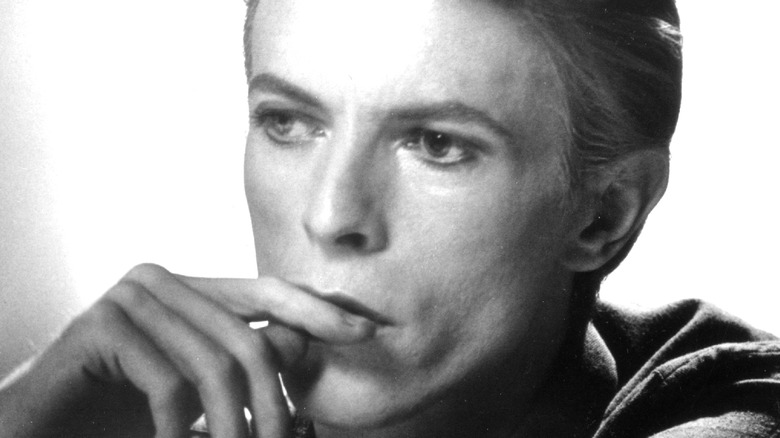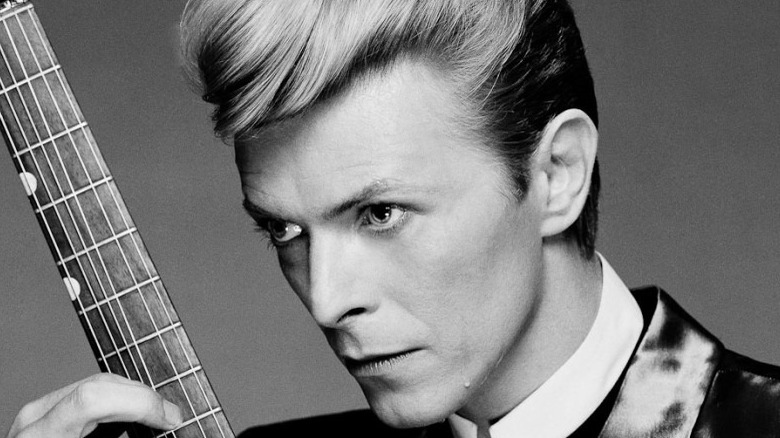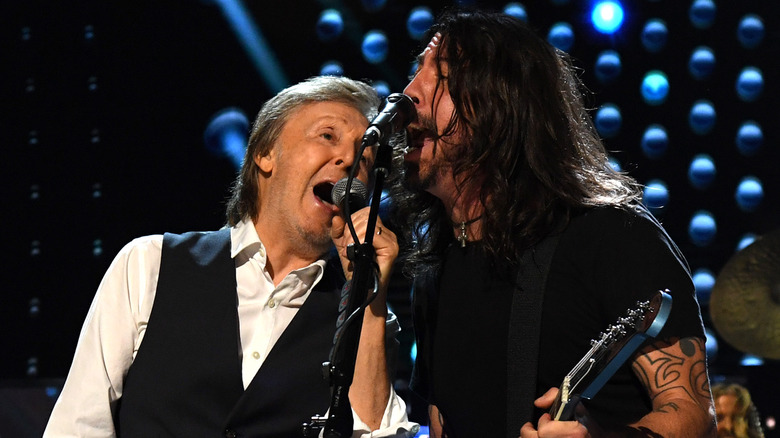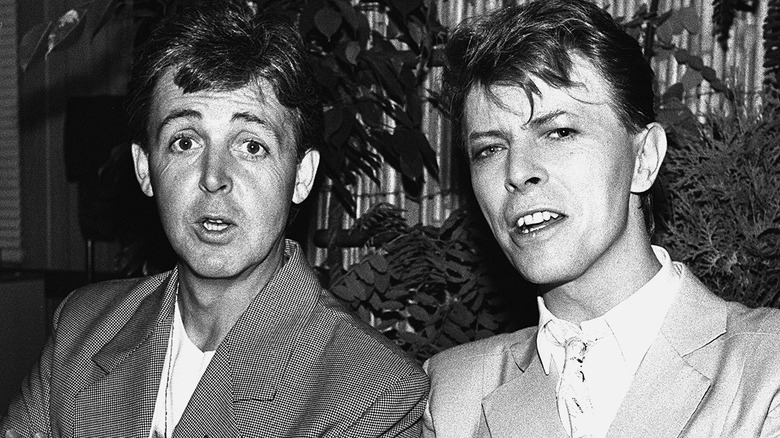The Priceless Reaction David Bowie Had To Paul McCartney's Portrait Of Him
Sales of over 183 million Beatles albums in the United States alone (via Insider) might be enough of an accomplishment for some musical artists, but Sir Paul McCartney is not one of them. According to Bob Spitz's biography "The Beatles," in addition to being one of the most successful musicians of the last century, McCartney is also a gifted visual artist, with a talent for sketching and painting. While a student at the Liverpool Institute for Boys in the late 1950s, he won an award for his work, which was well-regarded by students and teachers alike, according to "Paul McCartney: A Life," by Peter Ames Carlin.
Even after the Beatles' emergence into global megastardom, McCartney's interest in visual arts remained keen. He was particularly interested in painters like Giorgio de Chirico and Willem de Kooning (according to Spitz), and found guidance and access to major contemporary artists through art dealer Robert Fraser (also according to Spitz).
In the 1980s, his first wife, Linda, gave him a mixed lot of materials from the studio of the Belgian surrealist painter René Magritte as a Christmas gift (according to Barry Miles's biography "Many Years From Now"). McCartney later purchased several paintings by Magritte, including "Le Jeu de Mourre," which inspired the logo for the Beatles' Apple Records (via Miles). The BBC reported that by the time he divorced his second wife, Heather Mills, in 2008, Paul McCartney's art collection also included paintings by Pablo Picasso and Pierre-Auguste Renoir.
David Bowie, arts omnivore
Throughout his career, David Bowie was known for his interest in and creative experiments across many media. Although he was most famous as a musician, his obituary in The New York Times noted that he also trained as a mime, acted in theater and film, and painted. His interest in painting was so intense that in the mid-'70s he considered abandoning his musical career to pursue painting full-time. As reported in his biography by Christopher Sandford, "Bowie: Loving The Alien," after relocating to Germany, Bowie cultivated a habit of visiting galleries and museums in Geneva and West Berlin, and by 1977 had established himself as both a collector and creator of contemporary art. In a 1978 interview (included in Sean Egan's "Bowie on Bowie: Interviews and Encounters with David Bowie") he spoke of painting as such a consuming interest that he was "painting very seriously now, every available moment."
Challenging himself as an artist was a central tenet of Bowie's approach to art, stating in an interview for Michael Apted's 1997 documentary "Inspirations" (later posted to YouTube) that artists should "go a little bit out of your depth, and when you don't feel that your feet are quite touching the bottom, you're just about in the right place to do something exciting." He lived that ethos by working in a variety of media and collaborating with photographers, set designers, and fellow painters as much as in his music career (via The Victoria and Albert Museum). In the 1990s, Bowie worked alongside artist Beezy Bailey, with the resulting paintings being shown in exhibitions in London (1995) and Basel, Switzerland (1996) (via The New York Times).
Bowie and McCartney's Legacies
David Bowie and Paul McCartney's long careers reflect their commitment to growing as artists decades after the peaks of their fame. They were also united in their strong investment in shaping and maintaining their artistic legacies.
Bowie died in 2016 just after releasing "Blackstar," his 34th album since his debut in 1967. Per Metacritic, the album was very well received upon release, and was included in many best-of-the-year lists (aggregated by Metacritic). As reported by Billboard, in 2010, Bowie opened his personal archives to curators at the Victoria and Albert Museum to select items from throughout his life for a massive retrospective traveling exhibition, "David Bowie is." Curators had free rein over what items to include and how to present them, yielding an immersive approach which proved wildly popular. In accordance with Bowie's request, the exhibition had its final stop at the Brooklyn Museum in 2018.
McCartney, too, maintains a vigorous approach to his creative output. In early 2020, when the COVID-19 pandemic first hit the United States, he recorded "McCartney III," the third in a series of albums on which he plays all instruments. The album was released in December 2020 to very positive reviews (via Metacritic). In 2021 alone, he carefully tended his legacy and contemporary relevance by publishing a landmark collection of his song lyrics, aptly titled "Lyrics: 1956 to The Present," co-producing the Peter Jackson-directed miniseries "The Beatles: Get Back," and inducting Foo Fighters into the Rock and Roll Hall of Fame.
Bowie's response to McCartney's unconventional portrait
So what about Paul McCartney's portrait of David Bowie, and Bowie's response to it? This, too, is a story that plays out over time — nearly 20 years.
As reported in Far Out magazine, McCartney's approach to painting was pretty laid-back. Rather than setting out to paint a portrait of Bowie, he realized as he completed the painting that his colleague's face had unconsciously emerged. That in itself is not unusual, but it's not a classic example of a portrait, in large part because it depicts David Bowie vomiting copiously. This uncommon activity in portraiture is what led to McCartney dubbing it "Bowie Spewing."
As McCartney was planning to show the piece in a 1990 exhibit in Siegen, Germany, he thought it would be a courtesy to check with Bowie that he wouldn't be offended by it. As Bowie later put it in an interview with Humo magazine (quoted by Far Out), "Paul sent me a picture of the painting, together with the question if I would mind the title of it. I answered 'Of course not, but what a coincidence, I am currently working on a song that's called 'McCartney S****.'"
According to a 2018 profile in GQ, it seems that McCartney didn't know about Bowie's cheeky response until his interviewer asked him about it, replying dryly, "I never saw that. But, you know, he was a jovial character."



